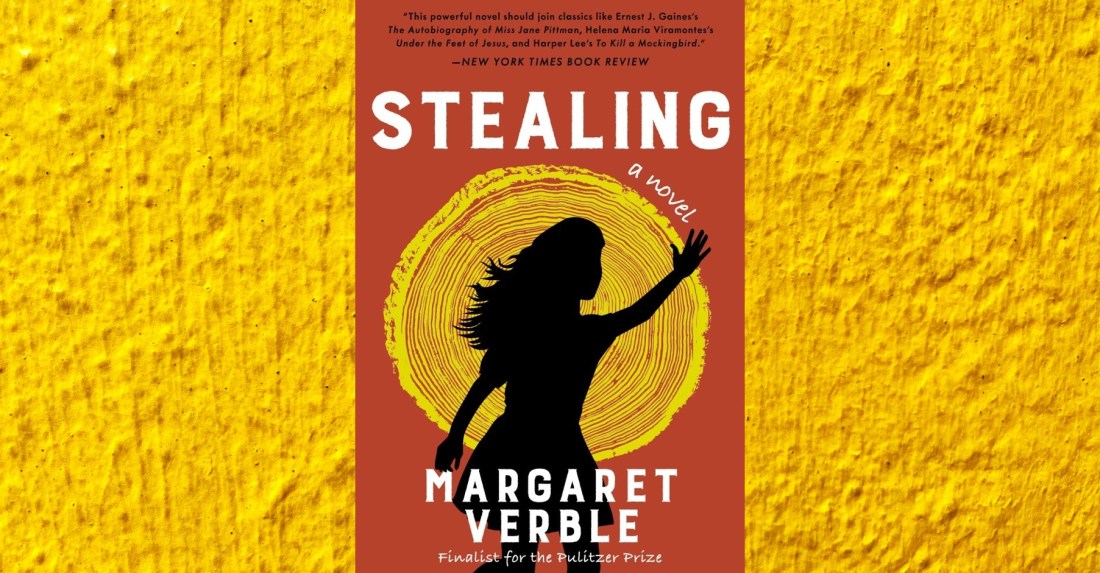Narrated in the first person, Stealing by Margaret Verble is an astute delivery of the plight Indigenous American children were forced into in the 1950s. As a descendant of the Cherokee nation, Verble offers a complex and descriptive view into the pain, confusion, abuse, and upheaval these children faced, and does so from the relatable point of view of a young girl in the thick of it.
Karen “Kit” Crockett is growing up in the 1950s South and has seen her share of tragedies. Her mother, a member of the Cherokee Nation whose people survived the Trail of Tears, died of tuberculosis, and Kit is left to fend for herself as her white father – a man who lived through the trials of the war – is working to provide for them and survive his own grief. Then, one day, her Uncle Joe – her mother’s brother – is murdered in a bar fight, and they find themselves not only grieving his loss, but sorting out the injustices of his death.
Every day, while her father is working, Kit sets off down the trail, past her uncle’s old cabin, and to the river with her fishing pole and snake stick. Then, one day, she notices her uncle’s cabin is no longer vacant. Instead, a young woman in her twenties seems to be its new occupant. Kit takes the opportunity to introduce herself, offer the new tenant some fish, and find out just who this person is using her uncle’s refrigerator, his chicken house, his bed. Her name is Bella, and Kit is drawn to her immediately.
Kit states, “…what struck me about her at first sighting, beyond just the way she was standing there with her hand on her hope and her head cocked like she was waiting for me, was that she had the prettiest hair I’d ever seen.” Additionally, Kit is drawn to Bella because she has dark skin just like her, like her mom, even though Bella is of multiple American Indian lineages. Kit and Bella strike up a quick and symbiotic relationship. They are maternal and sisterly. They are neighborly and timid. They love to spend time talking about the chickens and guineas while braiding hair and sharing food. This is not to say, though, that their relationship isn’t frowned upon by some.
As quickly as Kit takes to Bella, another neighbor shows an immediate distaste for her. Between the fact that Bella is divorced, hosts multiple men in her home, is not white, and shows affection towards a motherless nine-year-old, girl, Mrs. Burnett is appalled and disgraced with the woman living in Uncle Joe’s cabin. One day, after Kit is injured in a fishing incident, the nosy neighbor views Bella tenderly addressing Kit’s injury – and this is where it all unravels.
The rest of the novel details the events that transpired after that wound-tending: not one but two more murders that occur, the transferring of homes, and the terrible verbal and sexual abuse that transpires. Every detail we receive, from start to end, is told in an almost epistolary concept, as Kit writes in her journal and jumps timelines from “before” the incident to “after.” With everything she has been through in her short existence, Kit uses her love of Nancy Drew to determine she must leave a written record about her situation. She details her home life, her friendship with Bella, the injustices of her uncle, and the abuses endured while living with the Pastor and his unstable wife in between being stolen from her home and being imprisoned at Ashley Lordard, the Christian boarding school she and other Cherokee, Chickasaw, and Comanche children are forced to attend. There, they have their hair cut off and are indoctrinated with staunch Christian teachings. They are not allowed to speak in their native languages. Girls of Indigenous American culture are not allowed to hang out in groups with each other. And the sexual abuse inflicted by the man who preaches and leads the children seems to solely focus his predatorial practices on the American Indian girls.
Kit has had so much taken from her, but she has the knowledge that she, like so many before her, is a survivor. In one journal entry, Kit said, “I don’t think you can really love somebody and not need them and want them to need you. We aren’t like silos out in the fields, we’re more like fences connected to each other. We have to have our own posts in the ground to keep from sagging, but a line of fence just standing out alone doesn’t keep anything in or anything out.” Through all her struggles, she’s held on to the fact that she comes from a strong lineage and there are still family members out there who love her and want her, if only she can find her way to them. Kit goes on to impart, “But a lot of the girls here have already given up… But not me. I’m not going to be that fence standing alone out in the field, so I don’t give up hope. That would be against my nature. I am descended from people who survived the Trail of Tears.”
Although I’d love to have seen more of Kit’s father’s storyline – we never do see the full story of why he did what he did – there are so many relevant issues being tackled in the compact novel. Themes of religion, class, abuse, prejudice, and identity are just few larger issues covered from the lens of a young child, lending these issues the innocence and hopefulness one might need when delving into such weighty topics.
Verble’s depiction of a period of violence against the Indigenous American community that is being uncovered more and more each day is a true testament to her ability as a storyteller. She is able to write with sensitivity while simultaneously expressing the atrocities that her ancestors endured. All-in-all, works of historical fiction like Stealing are essential, hard as they may be to read.
FICTION
Stealing
By Margaret Verble
Published February 20, 2024
Mariner Books


